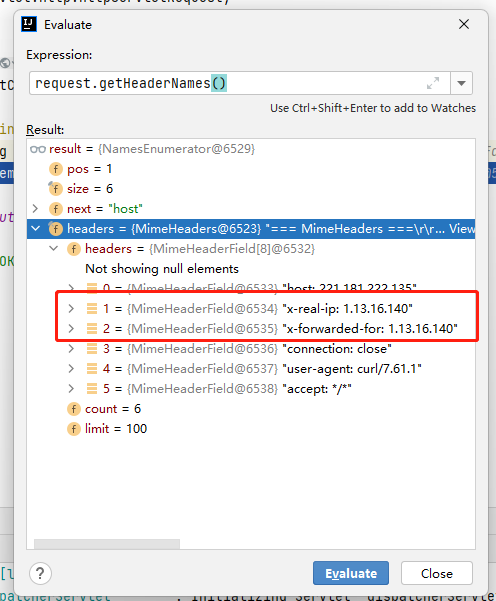【Nginx】如何获取客户端真实IP、域名、协议、端口
工作中实际使用,获取客户端实际ip
refer to : https://juejin.cn/post/6844903688037908488
1.编译时,需要增加realip这个module
./configure --with-http_realip_module
2.nginx.conf如下:
#user nobody;
worker_processes 1;
#error_log logs/error.log;
#error_log logs/error.log notice;
#error_log logs/error.log info;
#pid logs/nginx.pid;
events {
worker_connections 1024;
}
http {
include mime.types;
default_type application/octet-stream;
#log_format main '$remote_addr - $remote_user [$time_local] "$request" '
# '$status $body_bytes_sent "$http_referer" '
# '"$http_user_agent" "$http_x_forwarded_for"';
#access_log logs/access.log main;
sendfile on;
#tcp_nopush on;
#keepalive_timeout 0;
keepalive_timeout 65;
#gzip on;
upstream backend {
server 192.168.10.8:8069;
}
server {
listen 80;
server_name localhost;
#charset koi8-r;
#access_log logs/host.access.log main;
location / {
proxy_pass http://backend;
proxy_set_header Host $host;
proxy_set_header X-Real-IP $remote_addr;
proxy_set_header X-Forwarded-For $proxy_add_x_forwarded_for;
real_ip_header X-Forwarded-For;
real_ip_recursive on;
root html;
index index.html index.htm;
}
#error_page 404 /404.html;
# redirect server error pages to the static page /50x.html
#
error_page 500 502 503 504 /50x.html;
location = /50x.html {
root html;
}
# proxy the PHP scripts to Apache listening on 127.0.0.1:80
#
#location ~ \.php$ {
# proxy_pass http://127.0.0.1;
#}
# pass the PHP scripts to FastCGI server listening on 127.0.0.1:9000
#
#location ~ \.php$ {
# root html;
# fastcgi_pass 127.0.0.1:9000;
# fastcgi_index index.php;
# fastcgi_param SCRIPT_FILENAME /scripts$fastcgi_script_name;
# include fastcgi_params;
#}
# deny access to .htaccess files, if Apache's document root
# concurs with nginx's one
#
#location ~ /\.ht {
# deny all;
#}
}
# another virtual host using mix of IP-, name-, and port-based configuration
#
#server {
# listen 8000;
# listen somename:8080;
# server_name somename alias another.alias;
# location / {
# root html;
# index index.html index.htm;
# }
#}
# HTTPS server
#
#server {
# listen 443 ssl;
# server_name localhost;
# ssl_certificate cert.pem;
# ssl_certificate_key cert.key;
# ssl_session_cache shared:SSL:1m;
# ssl_session_timeout 5m;
# ssl_ciphers HIGH:!aNULL:!MD5;
# ssl_prefer_server_ciphers on;
# location / {
# root html;
# index index.html index.htm;
# }
#}
}
3.测试
1.13.16.140发起请求 ----> 221.181.222.135(192.168.10.66)----> 192.168.10.8(Java服务)
在1.13.16.140服务器上,执行以下命令
curl http://221.181.222.135:9898/test/realIp
Java服务的controller层,使用HttpServletRequest 获取header如下:

其中1.13.16.140就是我们真实的客户端ip
Nginx获取客户端信息
注意:本文中的客户端信息指的是:客户端真实IP、域名、协议、端口。
Nginx反向代理后,Servlet应用通过request.getRemoteAddr()取到的IP是Nginx的IP地址,并非客户端真实IP,通过request.getRequestURL()获取的域名、协议、端口都是Nginx访问Web应用时的域名、协议、端口,而非客户端浏览器地址栏上的真实域名、协议、端口。
直接获取信息存在哪些问题?
例如在某一台IP为192.168.1.100的服务器上,Jetty或者Tomcat端口号为8080,Nginx端口号80,Nginx反向代理8080端口:
server {
listen 80;
location / {
proxy_pass http://127.0.0.1:8080; # 反向代理应用服务器HTTP地址
}
}
在另一台机器上用浏览器打开http://192.168.1.100/test访问某个Servlet应用,获取客户端IP和URL:
System.out.println("RemoteAddr: " + request.getRemoteAddr());
System.out.println("URL: " + request.getRequestURL().toString());
打印的结果信息如下:
RemoteAddr: 127.0.0.1
URL: http://127.0.0.1:8080/test
可以发现,Servlet程序获取到的客户端IP是Nginx的IP而非浏览器所在机器的IP,获取到的URL是Nginx proxy_pass配置的URL组成的地址,而非浏览器地址栏上的真实地址。如果将Nginx用作https服务器反向代理后端的http服务,那么request.getRequestURL()获取的URL是http前缀的而非https前缀,无法获取到浏览器地址栏的真实协议。如果此时将request.getRequestURL()获取得到的URL用作拼接Redirect地址,就会出现跳转到错误的地址,这也是Nginx反向代理时经常出现的一个问题。
如何解决这些问题?
既然直接使用Nginx获取客户端信息存在问题,那我们该如何解决这个问题呢?
我们整体上需要从两个方面来解决这些问题:
(1)由于Nginx是代理服务器,所有客户端请求都从Nginx转发到Jetty/Tomcat,如果Nginx不把客户端真实IP、域名、协议、端口告诉Jetty/Tomcat,那么Jetty/Tomcat应用永远不会知道这些信息,所以需要Nginx配置一些HTTP Header来将这些信息告诉被代理的Jetty/Tomcat;
(2)Jetty/Tomcat这一端,不能再获取直接和它连接的客户端(也就是Nginx)的信息,而是要从Nginx传递过来的HTTP Header中获取客户端信息。
具体实践
配置nginx
首先,我们需要在Nginx的配置文件nginx.conf中添加如下配置。
proxy_set_header Host $http_host;
proxy_set_header X-Real-IP $remote_addr;
proxy_set_header X-Forwarded-For $proxy_add_x_forwarded_for;
proxy_set_header X-Forwarded-Proto $scheme;
各参数的含义如下所示。
Host包含客户端真实的域名和端口号;
X-Forwarded-Proto表示客户端真实的协议(http还是https);
X-Real-IP表示客户端真实的IP;
X-Forwarded-For这个Header和X-Real-IP类似,但它在多层代理时会包含真实客户端及中间每个代理服务器的IP。
此时,再试一下request.getRemoteAddr()和request.getRequestURL()的输出结果:
RemoteAddr: 127.0.0.1
URL: http://192.168.1.100/test
可以发现URL好像已经没问题了,但是IP还是本地的IP而非真实客户端IP。但是如果是用Nginx作为https服务器反向代理到http服务器,会发现浏览器地址栏是https前缀但是request.getRequestURL()获取到的URL还是http前缀,也就是仅仅配置Nginx还不能彻底解决问题。
通过Java方法获取客户端信息
仅仅配置Nginx不能彻底解决问题,那如何才能解决这个问题呢?一种解决方式就是通过Java方法获取客户端信息,例如下面的Java方法。
/***
* 获取客户端IP地址;这里通过了Nginx获取;X-Real-IP
*/
public static String getClientIP(HttpServletRequest request) {
String fromSource = "X-Real-IP";
String ip = request.getHeader("X-Real-IP");
if (ip == null || ip.length() == 0 || "unknown".equalsIgnoreCase(ip)) {
ip = request.getHeader("X-Forwarded-For");
fromSource = "X-Forwarded-For";
}
if (ip == null || ip.length() == 0 || "unknown".equalsIgnoreCase(ip)) {
ip = request.getHeader("Proxy-Client-IP");
fromSource = "Proxy-Client-IP";
}
if (ip == null || ip.length() == 0 || "unknown".equalsIgnoreCase(ip)) {
ip = request.getHeader("WL-Proxy-Client-IP");
fromSource = "WL-Proxy-Client-IP";
}
if (ip == null || ip.length() == 0 || "unknown".equalsIgnoreCase(ip)) {
ip = request.getRemoteAddr();
fromSource = "request.getRemoteAddr";
}
return ip;
}
这种方式虽然能够获取客户端的IP地址,但是我总感觉这种方式不太友好,因为既然Servlet API提供了request.getRemoteAddr()方法获取客户端IP,那么无论有没有用反向代理对于代码编写者来说应该是透明的。
接下来,我就分别针对Jetty服务器和Tomcat服务器为大家介绍下如何进行配置才能更加友好的获取客户端信息。
Jetty服务器
在Jetty服务器的jetty.xml文件中,找到httpConfig,加入配置:
重新启动Jetty,再用浏览器打开http://192.168.1.100/test测试,结果:
RemoteAddr: 192.168.1.100
URL: http://192.168.1.100/test
此时可发现通过request.getRemoteAddr()获取到的IP不再是127.0.0.1而是客户端真实IP,request.getRequestURL()获取的URL也是浏览器上的真实URL,如果Nginx作为https代理,request.getRequestURL()的前缀也会是https。
另外,Jetty将这个功能封装成一个模块:http-forwarded。如果不想改jetty.xml配置文件的话,也可以启用http-forwarded模块来实现。
例如可以通过命令行启动Jetty:
java -jar start.jar --module=http-forwarded
更多Jetty如何启用模块的相关资料可以参考:http://www.eclipse.org/jetty/documentation/current/startup.html
Tomcat
和Jetty类似,如果使用Tomcat作为应用服务器,可以通过配置Tomcat的server.xml文件,在Host元素内最后加入:
<Valve className="org.apache.catalina.valves.RemoteIpValve" />